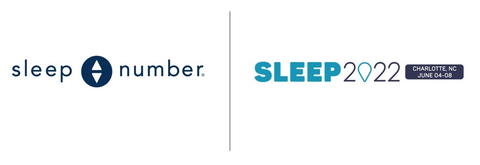Sleep Number Unveils New Research from Its 360® Smart Bed on Temperature Sensing and Daytime Alertness
Temperature study revealed at SLEEP 2022 demonstrates ability to unobtrusively measure body temperature during sleep.
Daytime alertness study shows potential of the 360 smart bed to predict alertness trends in large populations under real-world conditions.

Temperature meaningfully impacts sleep quality, and alertness is an indicator of sleep’s impact on daytime performance. These studies further demonstrate Sleep Number’s ability to provide unparalleled quality sleep, as well as the 360 smart bed’s potential research capabilities to accurately assess and monitor sleep using non-invasive, longitudinal methodology. To date,
Unobtrusive Sensing of Skin Temperature During Sleep Using a Mattress Sensor
Body and ambient temperature significantly influence sleep patterns, both in falling asleep and staying asleep. As the body prepares for sleep, temperature increases in distal (hands and feet) and proximal (abdomen) areas, while core body temperature decreases. The ratio of distal to proximal temperature can be highly predictive of sleep onset, which can offer insight into one’s sleep quality. However, there are few devices that can measure these temperatures unobtrusively. Sleep Number’s study sought to unobtrusively estimate distal skin temperature during sleep using a temperature sensor array on a bed.
Three participants’ skin temperatures were measured using five equally spaced temperature sensors set laterally across the bed to align with the torso.
Results of the study showed that a temperature sensor system, coupled with an optimized decision-tree model to predict distal skin temperature for each minute, can predict a mean distal sleep temperature for each sleep session with reasonable accuracy. This study also showed the 360 smart bed platform with the sensor array enabled unobtrusive, real-world collection of distal skin temperatures during sleep and may be useful for future studies measuring overnight temperature.
“The research we’re presenting at SLEEP 2022 demonstrates our commitment to our mission, to improve lives by individualizing sleep experiences,” said
Daytime Alertness Quantification and Modelling: Results from a Large Observational Study
Poor quality sleep is associated with a broad range of health risks such as chronic illnesses, impaired vigilance and cognitive issues, including alertness. Understanding and predicting alertness trends throughout the day can better inform daytime performance.
Previously, the two-process model (TPM) of sleep regulation combining sleep homeostasis and circadian rhythm has been used to derive a daytime alertness curve. The TPM model has been used to model the effects of sleep deprivation on memory, circadian misalignment, temperature regulation and brain function; however, the TPM-derived alertness curve comes largely from small-scale, controlled studies. Sleep Number’s study showed that a similar, three-parameter alertness measure, which included sleep homeostasis, circadian rhythm and self-rated alertness responses from 360 smart bed sleepers can scale to a large group of people under real-world conditions.
Human sleep is regulated by two components: sleep homeostasis and circadian rhythms. Sleep homeostasis, or pressure to sleep, builds up in the body as time awake increases and decreases during sleep. Circadian rhythms are natural, internal cycles of biological and behavioral processes that rise and fall across the 24-hour day. Circadian rhythms promote sleepiness before usual bedtime, help initiate sleep and begin promoting wakefulness before usual wake-up time in the morning.
The study showed that:
- Overall, subjective alertness followed a similar trend to previous studies: mean hourly alertness increased in the morning, dipped slightly in the afternoon, increased during the evening and decreased again during the night. Unlike previous studies, however, this study saw a greater increase in alertness from the afternoon to evening.
-
Based upon the demographic makeup of the sleeper population,
Sleep Number was also able to analyze hourly trends in mean alertness scores by age group. Younger sleepers had the most stable alertness scores throughout the day, but lower levels of alertness compared to older age groups. In contrast, middle-aged and older sleepers had higher levels of alertness, but their score varied more widely throughout the day compared to younger sleepers. - These results show that TPM-derived alertness can effectively predict daily alertness trends in a large group of people under real-world conditions.
Quality sleep is associated with overall health and wellbeing, which is why all
“Last year, in listening to our sleepers’ feedback, we released My Daytime Alertness, a feature that provides advanced, real-time insights that pair each sleeper’s personal sleep data with self-reported information and sleep science,” said Rajasi Mills, VP of
Recently,
About
Individuality is the foundation of
Our award-winning 360® smart beds are informed by science. They learn from over one billion sleep sessions of highly-accurate, real world sleep data – the culmination of over 15 billion hours’ worth - to automatically adjust to each sleeper and provide effortless comfort and proven quality sleep. Our 360 smart beds deliver individualized sleep health reports and insights, including a daily SleepIQ® score, and are helping to advance meaningful sleep health solutions by applying sleep science and research.
For life-changing sleep, visit SleepNumber.com or one of our 650
Forward-looking Statements
Statements used in this news release relating to future plans, events or performance such as the 360 smart bed’s potential research capabilities are forward-looking statements subject to certain risks and uncertainties. Additional information concerning these and other risks and uncertainties is contained in the company’s filings with the
View source version on businesswire.com: https://www.businesswire.com/news/home/20220608005434/en/
Sleep Number Public Relations
Julie.Elepano@sleepnumber.com
Sleep Number Public Relations
Nichole.Teixeira@sleepnumber.com
Source:







